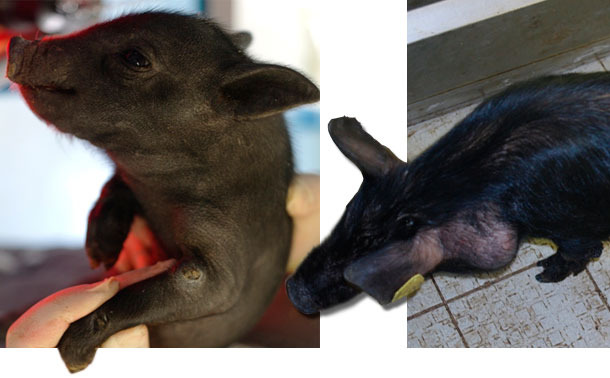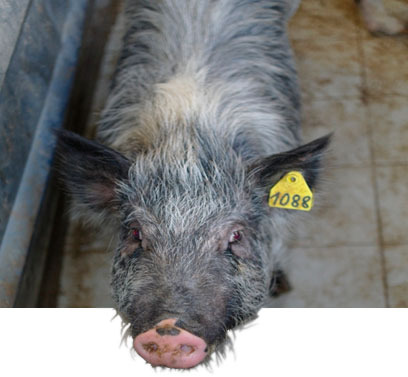Heterosis (also known as Hybrid Vigour) and inbreeding are important in pig production. Heterosis comes from cross-breeding while inbreeding occurs in purebreds. They have opposite effects, the former improves performance and the latter decreases performance, particularly in reproductive traits.
Genes are inherited in pairs, one from each parent. Heterosis increases the number of different allele pairs and increases heterozygosity, resulting in the suppression of undesirable recessive alleles from one parent by dominant alleles from the other parent. Inbreeding results in homozygosity, which increases the chances of offspring being affected by recessive or deleterious traits.

Heterosis
The benefits of hybridisation, through the exploitation of heterosis are well proven through scientific experiment and commercial recording. There are three components to heterosis: individual (occurring when offspring are crossbred), maternal (when the dam is crossbred) and paternal (when the sire is crossbred). Thus a cross between two purebreds will produce progeny exhibiting individual heterosis, which will show improved survival rates. However, if the mother is herself crossbred, then she will show improved numbers of piglets born and a better rebreeding interval because of maternal heterosis. Paternal heterosis mainly affects libido and semen production traits.
As an example of the improvements that come from heterosis, let us assume that a purebred nucleus population produces 24 pigs a sow per year. Merely, by crossing with another breed (as in multiplication) will give a performance increase of 6%. When the crossbred female is then mated with a third breed the increase in performance over purebreeding is 17%:
| Sire Breed | Dam Breed | % | Pigs/ sow/year | Benefit* | |
| Purebreeding (GGP) | A | A | 100 | 24.0 | - |
| Multiplication (GP) | A | B | 106 | 25.4 | +1.4 |
| Commercial (Three breed) | A | BC | 117 | 28.1 | +4.1 |
* Improvement in pigs/sow/year over purebreeding
Note that the exact levels of production from various mating plans will depend on the genetic potential of the composite breeds, and the exact system of crossbreeding. For example, synthetic lines and back-cross/criss-cross lines do not maximise heterosis and will not be as effective as the ‘optimum’ three breed system. This partially explains why the first cross sow with a third breed of terminal sire is the general system of choice in global pig production.
Inbreeding
The ‘reverse’ of heterosis is inbreeding where there is depression in reproductive performance due to the mating of closely related animals. Inbreeding particularly reduces performance in litter size, piglet weights, puberty attainment and boar libido. In addition, inbreeding can lead to an increase in certain defects (for example, see the Online Mendelian Inheritance in Animals (OMIA) database.
The level of inbreeding is measured by the inbreeding coefficient, which depends on the degree of relationship between animals. Inbreeding coefficients can be calculated for individual sires, individual dams and litters.
Data from several research trials have shown that inbreeding has significant effects on herd performance. For example, a 10 % inbreeding coefficient in a litter and in a sow (not uncommon in some small closed pyramids) results in the following declines in litter size:

| Born alive | 3 weeks | |
| Inbred litter | -0.32 | -0.58 |
| Inbred dam | -0.44 | -0.24 |
The typical target inbreeding level for a ‘closed’ GGP herd is less than 2% - this means that the control of the mating programme is vital. Breeding company nucleus GGP populations maintain genetic variation and control inbreeding through sophisticated mating plans.
Inbreeding is directly related to the size of a population, thus the smaller a nucleus, the faster it tends to lose genetic diversity and the higher the inbreeding depression. Maintenance of a sufficient number of sires per generation is particularly important.
Traditional breeds, because of their often small size and low number of sires are particularly prone to high inbreeding. In some more advanced programmes, control of inbreeding is achieved by:
- The identification of the relationship (kinship) of each living animal with all other animals in the breed.
- The estimation of inbreeding coefficients for future matings (‘what if’ inbreeding levels for potential matings).
- The identification of relatively unrelated boars matched to females prior to breeding (mate-selection).
Inbreeding pig populations are often used in medical research programmes because of the ‘concentration’ of deleterious alleles. A famous example is in the MeLim breed used to study malignant melanoma. Researchers have found that some of these pigs ‘self-cure’ and the underlaying genes are being investigated.

| Image 1. MeLim piglets are frequently born with melanoma. Source: Prof. Chris Moran. |
Image 2. Pig with advanced metastatic tumour in lymph glands. Source: Prof. Chris Moran. |

Image 3. In some pigs the tumours disappear. It involves a partial or total change
of colour from black to white as well. Source: Prof. Chris Moran.


